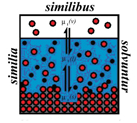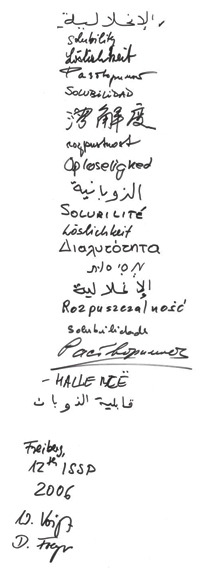|
|
Vol.
30 No. 2
March-April 2008
Solubility Data Compilations for the Practicing Chemist
by Heinz Gamsjäger, John W. Lorimer, and David G. Shaw
Phenomena related to the solubility of solids, liquids, and gases with one another are of interest to scientists, technologists, and medical practitioners in a wide array of disciplines. Solubility data are, for example, employed to determine thermodynamic quantities, and to predict the safety of radioactive waste repositories as well as to assess the effectiveness of a given pharmacological treatment. Clearly, the end users of solubility concepts and/or solubility data are interested in compilations of data that are critically evaluated by experts, and recommended values that are presented in tables, figures, or fitting equations.
 |
One of the major activities of IUPAC is the critical evaluation of physico-chemical data. This includes the Solubility Data Project, a task undertaken by the Subcommittee on Solubility and Equilibrium Data (SSED), a subcommittee of the Division of Analytical Chemistry. The SSED coordinates the dissemination of the evaluated solubility data through traditional (journal) and electronic (internet-accessible database) means. It works with the Analytical Chemistry Division and the U.S. National Institute of Standards and Technology (NIST), the Solubility Data Series publisher, in the selection of chemical systems for treatment. The SSED also encourages the formation of task groups to perform compilation and evaluation and assists task groups in carrying out their projects. The objectives of, and historical details on, the IUPAC Solubility Data Project can be found in a previous issues of CI.1,2
 |
| The word “solubility” as spelled out in 19 different languages by participants at the 12th International Symposium on Solubility Phenomena, held in July 2006 in Freiberg, Germany. |
The ongoing core project of SSED is the publication of exhaustively compiled and critically evaluated reviews of experimental solubility data. The main output of this work is the IUPAC-NIST Solubility Data Series, or simply the SDS. The first 65 volumes of the SDS were published as monographs between 1979–1996. Starting with Volume 66 in 1998, the SDS has on average published two volumes a year in the Journal of Physical and Chemical Reference Data (JPCRD). The JPCRD is a bimonthly journal published jointly by the American Institute of Physics and the NIST with the objective of providing critically evaluated physical and chemical property data, fully documented as to the original sources and the criteria used for evaluation. At the time of this writing the SDS had reached volume 83.3 Solubility data compiled and evaluated for the SDS are also available through the IUPAC-NIST Solubility Database.4
In addition, since 1984, the subcommittee has organized the popular series of IUPAC-sponsored International Symposia on Solubility Phenomena, abbreviated ISSP, which are held in even-numbered years. These conferences deal with all aspects of solubility and properties of solutions such as thermodynamics, kinetics and general analytical chemistry as applied to theoretical chemistry, industrial processes, the environment, biochemistry, methods of compiling and critically evaluating solubility data, and databases. The most recent conference, the 12th International Symposium on Solubility Phenomena—Including Related Equilibrium Processes, was held from 23–28 July 2006 in Freiberg, Germany.
Plenary and invited lectures presented at these conferences are published in Pure and Applied Chemistry.6 These conferences have become the main scientific event of the solubility community. These symposia accomplish the IUPAC mission of effectively promoting the cooperation of scientists who speak different languages, use different alphabets, and belong to different cultures.7 This fact is symbolized by the “Rosetta” list of the word “solubility” (below) as it is spelled in 19 different languages. The next symposium, the 13th ISSP, will be held 27–31 July 2008 in Dublin, Ireland (see Where 2B & Y, p. 37).
The international cooperation behind the solubility data projects, as well as the solubility symposia, has created quite an ambitious scientific atmosphere. Thus, in addition to the SDS, the SSED has been involved in publishing standard reference texts dealing with solubility phenomena. For example, The Experimental Determination of Solubilities,8 and Chemicals in the Atmosphere: Solubility, Sources and Reactivity.9 IUPAC Recommendations titled “Glossary of Terms Related to Solubility” was recently published in Pure and Applied Chemistry.10 Members of the solubility group have also edited or contributed to several books covering the whole range of development and applications of solubility data and concepts.11,12,13 It is recommended that those interested in the activities of the solubility data group consult the homepage14 of the SSED, and the three introductions to the gas/liquid, liquid/liquid and solid/liquid series in particular.15
To conclude this review, we emphasize two unconventional “tools of the solubility trade.” Each volume of the SDS represents several years of sustained effort by a team of three or more senior scientists. One outcome is the excellent social relations and good friendships that have developed among the members of the solubility group during several decades of scientific cooperation. This friendship guarantees a stable balance between traditional and innovative approaches toward compilation, evaluation, and publication of solubility data. The recruitment of highly qualified young scientists to continue and expand this work requires significant effort from the current participants. The Franzosini Prize, awarded regularly by SSED to a younger scientist contributing to IUPAC’s compilation and evaluation of solubility data, is an important recruiting tool.5
References
1.
J.W. Lorimer (1996), CI, 18(2),
47–50.
2. H.L. Clever (2004), CI,
26(3), 12–15.
3. V.P. Sazonov, D.G. Shaw, A. Skrzecz, N.I.
Lisov, and N.V. Sazonov, SDS 83 (2007), JPCRD, 36,
733–1131.
4. http://srdata.nist.gov/solubility/
5. www.iupac.org/divisions/V/502/Franzosini-Award.html
6. E. Waghorne (2007), Pure
Appl. Chem. 79(5),
iv.
7. H. Gamsjäger and W. Voigt (2006),
CI,
28(6), 31–32.
8. G.T. Hefter and R.P.T. Tomkins, editors,
The Experimental Determination of Solubilities (2003)
John Wiley & Sons, (ISBN: 0-471-49708-8).
9. P.G.T. Fogg and J. Sangster, editors, Chemicals
in the Atmosphere: Solubility, Sources and Reactivity
(2003) John Wiley & Sons, (ISBN: 0-471-98651-8).
10. H. Gamsjäger, J.W. Lorimer, P. Scharlin,
and D.G. Shaw (2008), Pure
Appl. Chem.
80(2), 233-276; doi:10.1351/pac200880020233
11. E. Königsberger and L.-C. Königsberger,
editors, Biomineralization–Medical Aspects of Solubility
(2006) John Wiley & Sons, (ISBN: 978-0-470-09209-5).
12. T.M. Letcher, editor, Developments
and Applications in Solubility (2006) The Royal Society
of Chemistry,
(ISBN 0 85404 372 1; ISBN-13 978 0 85404 372 9).
13. T.M. Letcher, editor, Thermodynamics,
Solubility and Environmental Issues (2007) Elsevier,
(ISBN-13: 978-0-444-52707-3; ISBN-10: 0-444-52707-9).
14. www.unileoben.ac.at/~IUPAC/welcome.html
15. www.unileoben.ac.at/~IUPAC/samples.html
Heinz Gamsjäger <[email protected]> is a professor at the Montanuniversität Leoben in Austria; John (known as Jack) W. Lorimer is a professor at the University of Western Ontario, in London, Ontario, Canada; David G. Shaw is at the Institute of Marine Science of the University of Alaska at Fairbanks, Fairbanks, Alaska, USA. They all are long-time active members, with a combined 59 years of service to IUPAC.
Page
last modified 25 March 2008.
Copyright © 2003-2008 International Union of Pure and Applied Chemistry.
Questions regarding the website, please contact [email protected] |